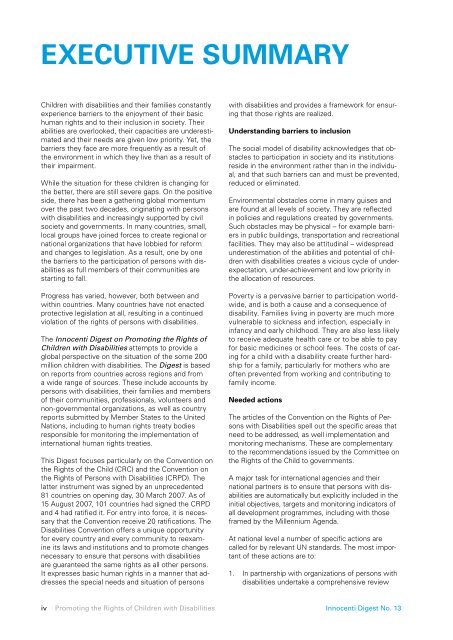Promoting the Rights of Children with Disabilities, UNICEF
Promoting the Rights of Children with Disabilities, UNICEF
Promoting the Rights of Children with Disabilities, UNICEF
- No tags were found...
You also want an ePaper? Increase the reach of your titles
YUMPU automatically turns print PDFs into web optimized ePapers that Google loves.
EXECUTIVE SUMMARY<strong>Children</strong> <strong>with</strong> disabilities and <strong>the</strong>ir families constantlyexperience barriers to <strong>the</strong> enjoyment <strong>of</strong> <strong>the</strong>ir basichuman rights and to <strong>the</strong>ir inclusion in society. Theirabilities are overlooked, <strong>the</strong>ir capacities are underestimatedand <strong>the</strong>ir needs are given low priority. Yet, <strong>the</strong>barriers <strong>the</strong>y face are more frequently as a result <strong>of</strong><strong>the</strong> environment in which <strong>the</strong>y live than as a result <strong>of</strong><strong>the</strong>ir impairment.While <strong>the</strong> situation for <strong>the</strong>se children is changing for<strong>the</strong> better, <strong>the</strong>re are still severe gaps. On <strong>the</strong> positiveside, <strong>the</strong>re has been a ga<strong>the</strong>ring global momentumover <strong>the</strong> past two decades, originating <strong>with</strong> persons<strong>with</strong> disabilities and increasingly supported by civilsociety and governments. In many countries, small,local groups have joined forces to create regional ornational organizations that have lobbied for reformand changes to legislation. As a result, one by one<strong>the</strong> barriers to <strong>the</strong> participation <strong>of</strong> persons <strong>with</strong> disabilitiesas full members <strong>of</strong> <strong>the</strong>ir communities arestarting to fall.Progress has varied, however, both between and<strong>with</strong>in countries. Many countries have not enactedprotective legislation at all, resulting in a continuedviolation <strong>of</strong> <strong>the</strong> rights <strong>of</strong> persons <strong>with</strong> disabilities.The Innocenti Digest on <strong>Promoting</strong> <strong>the</strong> <strong>Rights</strong> <strong>of</strong><strong>Children</strong> <strong>with</strong> <strong>Disabilities</strong> attempts to provide aglobal perspective on <strong>the</strong> situation <strong>of</strong> <strong>the</strong> some 200million children <strong>with</strong> disabilities. The Digest is basedon reports from countries across regions and froma wide range <strong>of</strong> sources. These include accounts bypersons <strong>with</strong> disabilities, <strong>the</strong>ir families and members<strong>of</strong> <strong>the</strong>ir communities, pr<strong>of</strong>essionals, volunteers andnon-governmental organizations, as well as countryreports submitted by Member States to <strong>the</strong> UnitedNations, including to human rights treaty bodiesresponsible for monitoring <strong>the</strong> implementation <strong>of</strong>international human rights treaties.This Digest focuses particularly on <strong>the</strong> Convention on<strong>the</strong> <strong>Rights</strong> <strong>of</strong> <strong>the</strong> Child (CRC) and <strong>the</strong> Convention on<strong>the</strong> <strong>Rights</strong> <strong>of</strong> Persons <strong>with</strong> <strong>Disabilities</strong> (CRPD). Thelatter instrument was signed by an unprecedented81 countries on opening day, 30 March 2007. As <strong>of</strong>15 August 2007, 101 countries had signed <strong>the</strong> CRPDand 4 had ratified it. For entry into force, it is necessarythat <strong>the</strong> Convention receive 20 ratifications. The<strong>Disabilities</strong> Convention <strong>of</strong>fers a unique opportunityfor every country and every community to reexamineits laws and institutions and to promote changesnecessary to ensure that persons <strong>with</strong> disabilitiesare guaranteed <strong>the</strong> same rights as all o<strong>the</strong>r persons.It expresses basic human rights in a manner that addresses<strong>the</strong> special needs and situation <strong>of</strong> persons<strong>with</strong> disabilities and provides a framework for ensuringthat those rights are realized.Understanding barriers to inclusionThe social model <strong>of</strong> disability acknowledges that obstaclesto participation in society and its institutionsreside in <strong>the</strong> environment ra<strong>the</strong>r than in <strong>the</strong> individual,and that such barriers can and must be prevented,reduced or eliminated.Environmental obstacles come in many guises andare found at all levels <strong>of</strong> society. They are reflectedin policies and regulations created by governments.Such obstacles may be physical – for example barriersin public buildings, transportation and recreationalfacilities. They may also be attitudinal – widespreadunderestimation <strong>of</strong> <strong>the</strong> abilities and potential <strong>of</strong> children<strong>with</strong> disabilities creates a vicious cycle <strong>of</strong> underexpectation,under-achievement and low priority in<strong>the</strong> allocation <strong>of</strong> resources.Poverty is a pervasive barrier to participation worldwide,and is both a cause and a consequence <strong>of</strong>disability. Families living in poverty are much morevulnerable to sickness and infection, especially ininfancy and early childhood. They are also less likelyto receive adequate health care or to be able to payfor basic medicines or school fees. The costs <strong>of</strong> caringfor a child <strong>with</strong> a disability create fur<strong>the</strong>r hardshipfor a family, particularly for mo<strong>the</strong>rs who are<strong>of</strong>ten prevented from working and contributing t<strong>of</strong>amily income.Needed actionsThe articles <strong>of</strong> <strong>the</strong> Convention on <strong>the</strong> <strong>Rights</strong> <strong>of</strong> Persons<strong>with</strong> <strong>Disabilities</strong> spell out <strong>the</strong> specific areas thatneed to be addressed, as well implementation andmonitoring mechanisms. These are complementaryto <strong>the</strong> recommendations issued by <strong>the</strong> Committee on<strong>the</strong> <strong>Rights</strong> <strong>of</strong> <strong>the</strong> Child to governments.A major task for international agencies and <strong>the</strong>irnational partners is to ensure that persons <strong>with</strong> disabilitiesare automatically but explicitly included in <strong>the</strong>initial objectives, targets and monitoring indicators <strong>of</strong>all development programmes, including <strong>with</strong> thoseframed by <strong>the</strong> Millennium Agenda.At national level a number <strong>of</strong> specific actions arecalled for by relevant UN standards. The most important<strong>of</strong> <strong>the</strong>se actions are to:1.In partnership <strong>with</strong> organizations <strong>of</strong> persons <strong>with</strong>disabilities undertake a comprehensive reviewiv <strong>Promoting</strong> <strong>the</strong> <strong>Rights</strong> <strong>of</strong> <strong>Children</strong> <strong>with</strong> <strong>Disabilities</strong> Innocenti Digest No. 13
















